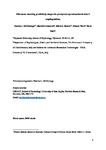Affordance matching predictively shapes the perceptual representation of others’ ongoing actions.
| dc.contributor.author | McDonough, K | |
| dc.contributor.author | Costantini, M | |
| dc.contributor.author | Hudson, Matthew | |
| dc.contributor.author | Ward, E | |
| dc.contributor.author | Bach, Patric | |
| dc.date.accessioned | 2020-03-31T14:44:09Z | |
| dc.date.issued | 2020-08 | |
| dc.identifier.issn | 0096-1523 | |
| dc.identifier.issn | 1939-1277 | |
| dc.identifier.uri | http://hdl.handle.net/10026.1/15481 | |
| dc.description.abstract |
Predictive processing accounts of social perception argue that action observation is a predictive process, in which inferences about others' goals are tested against the perceptual input, inducing a subtle perceptual confirmation bias that distorts observed action kinematics toward the inferred goals. Here we test whether such biases are induced even when goals are not explicitly given but have to be derived from the unfolding action kinematics. In 2 experiments, participants briefly saw an actor reach ambiguously toward a large object and a small object, with either a whole-hand power grip or an index-finger and thumb precision grip. During its course, the hand suddenly disappeared, and participants reported its last seen position on a touch-screen. As predicted, judgments were consistently biased toward apparent action targets, such that power grips were perceived closer to large objects and precision grips closer to small objects, even if the reach kinematics were identical. Strikingly, these biases were independent of participants' explicit goal judgments. They were of equal size when action goals had to be explicitly derived in each trial (Experiment 1) or not (Experiment 2) and, across trials and across participants, explicit judgments and perceptual biases were uncorrelated. This provides evidence, for the first time, that people make online adjustments of observed actions based on the match between hand grip and object goals, distorting their perceptual representation toward implied goals. These distortions may not reflect high-level goal assumptions, but emerge from relatively low-level processing of kinematic features within the perceptual system. (PsycInfo Database Record (c) 2020 APA, all rights reserved). | |
| dc.format.extent | 847-859 | |
| dc.format.medium | Print-Electronic | |
| dc.language | en | |
| dc.language.iso | en | |
| dc.publisher | American Psychological Association | |
| dc.subject | action understanding | |
| dc.subject | action prediction | |
| dc.subject | social perception | |
| dc.subject | predictive processing | |
| dc.subject | representational momentum | |
| dc.title | Affordance matching predictively shapes the perceptual representation of others’ ongoing actions. | |
| dc.type | journal-article | |
| dc.type | Journal Article | |
| plymouth.author-url | https://www.webofscience.com/api/gateway?GWVersion=2&SrcApp=PARTNER_APP&SrcAuth=LinksAMR&KeyUT=WOS:000557787900006&DestLinkType=FullRecord&DestApp=ALL_WOS&UsrCustomerID=11bb513d99f797142bcfeffcc58ea008 | |
| plymouth.issue | 8 | |
| plymouth.volume | 46 | |
| plymouth.publication-status | Published online | |
| plymouth.journal | Journal of Experimental Psychology: Human Perception and Performance | |
| dc.identifier.doi | 10.1037/xhp0000745 | |
| plymouth.organisational-group | /Plymouth | |
| plymouth.organisational-group | /Plymouth/Faculty of Health | |
| plymouth.organisational-group | /Plymouth/Faculty of Health/School of Psychology | |
| plymouth.organisational-group | /Plymouth/REF 2021 Researchers by UoA | |
| plymouth.organisational-group | /Plymouth/REF 2021 Researchers by UoA/UoA04 Psychology, Psychiatry and Neuroscience | |
| plymouth.organisational-group | /Plymouth/Research Groups | |
| plymouth.organisational-group | /Plymouth/Research Groups/Centre for Brain, Cognition and Behaviour (CBCB) | |
| plymouth.organisational-group | /Plymouth/Research Groups/Centre for Brain, Cognition and Behaviour (CBCB)/Brain | |
| plymouth.organisational-group | /Plymouth/Users by role | |
| plymouth.organisational-group | /Plymouth/Users by role/Academics | |
| dc.publisher.place | United States | |
| dcterms.dateAccepted | 2020-03-01 | |
| dc.rights.embargodate | 2020-4-2 | |
| dc.identifier.eissn | 1939-1277 | |
| dc.rights.embargoperiod | Not known | |
| rioxxterms.versionofrecord | 10.1037/xhp0000745 | |
| rioxxterms.licenseref.uri | http://www.rioxx.net/licenses/all-rights-reserved | |
| rioxxterms.type | Journal Article/Review | |
| plymouth.funder | One step ahead: Prediction of other people's behavior in healthy and autistic individuals.::ESRC |


